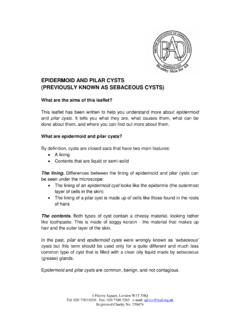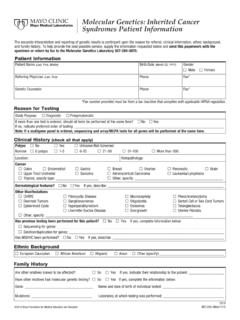Transcription of Diagnosing and treating Diamond Blackfan …
1 Diagnosing and treating Diamond Blackfan anaemia: results ofan international clinical consensus conferenceAdrianna Vlachos,1,2 Sarah Ball,3 Niklas Dahl,4 Blanche P. Alter,5 Sujit Sheth,6 Ugo Ramenghi,7 Joerg Meerpohl,8 Stefan Karlsson,9 Johnson M. Liu,1,2 Thierry Leblanc,10 Carole Paley,11 Elizabeth M. Kang,12 Eva Judmann Leder,1 Eva Atsidaftos,2 Akiko Shimamura,13 Monica Bessler,14 Bertil Glader15and Jeffrey M. Lipton,1,2on behalf of theparticipants of the Sixth Annual Daniella Maria Arturi International Consensus Conference1 The Feinstein Institute for Medical Research, Manhasset, NY,2 Schneider Children s Hospital, Albert Einstein College of Medicine, NewHyde Park, NY, USA,3St. George s Hospital Medical School, London, UK,4 Departments of Genetics and Pathology, Uppsala University,Uppsala, Sweden,5 Clinical Genetics Branch, Division of Cancer Epidemiology and Genetics, National Cancer Institute, Department ofHealth and Human Services, Bethesda, MD,6 Columbia University, New York, NY, USA,7 Universita`di Torino, Torino, Italy,8 Zentrumfuer Kinderheilkunde und Jugendmedizin, Universitaetsklinikum Freiburg, Freiburg, Germany,9 Lund University, Lund, Sweden,10Ho pital Saint-Louis, Paris, France,11 Novartis, East Hanover, NJ,12 National Institute of Allergy and Infectious Diseases, NationalInstitutes of Health, Bethesda, MD,13 Children s Hospital, Boston, MA,14 Washington University, St.
2 Louis, MO, and15 StanfordUniversity, Palo Alto, CA, USAS ummaryDiamond Blackfan anaemia (DBA) is a rare, genetically andclinically heterogeneous, inherited red cell aplasia. ClassicalDBA affects about seven per million live births and presentsduring the first year of life. However, as mutated genes havebeen discovered in DBA, non-classical cases with less distinctphenotypes are being described in adults as well as children. Incaring for these patients it is often difficult to have a clearunderstanding of the treatment options and their outcomesbecause of the lack of complete information on the naturalhistory of the disease. The purpose of this document is toreview the criteria for diagnosis, evaluate the availabletreatment options, including corticosteroid and transfusiontherapies and stem cell transplantation, and propose a plan foroptimizing patient care. Congenital anomalies, mode ofinheritance, cancer predisposition, and pregnancy in DBAare also reviewed.
3 Evidence-based conclusions will be madewhen possible; however, as in many rare diseases, the data areoften anecdotal and the recommendations are based upon thebest judgment of experienced clinicians. The recommendationsregarding the diagnosis and management described in thisreport are the result of deliberations and discussions at aninternational consensus : Diamond Blackfan anaemia, bone marrow failure,cancer predisposition, genetics, Blackfan anaemia (DBA; OMIM #205900) was firstreported by Josephs (1936) and refined as a distinct clinicalentity by Diamond and Blackfan (1938). It is now acceptedthat the disorder results from a cellular defect in whicherythroid progenitors and precursors are highly sensitive todeath by apoptosis, leading to erythropoietic failure (Liptonet al, 1986; Tsaiet al, 1989; Perdahlet al, 1994; Ohene-Abuakwaet al, 2005; Miyakeet al, 2008). DBA is a member ofa rare group of genetic disorders characterized by pro-apoptotic hematopoiesis leading to bone marrow failure,congenital anomalies (Grippet al, 2001) and predisposition tocancer (Liptonet al, 2001), known as the inherited bonemarrow failure syndromes (IBMFS) (Young & Alter, 1994).
4 The first DBA gene, mutated in approximately 25% ofpatients, has been cloned and was identified asRPS19, whichcodes for a ribosomal protein located at chromosome (Gustavssonet al, 1997; Draptchinskaiaet al, 1999). Thefunction of this protein in ribosome biogenesis is poorlyunderstood. In patients with anRPS19mutation, it has beenproposed that the disease results from rps19 protein haplo-insufficiency, where the protein produced by a single copyof a normal gene is not sufficient to produce normal function(reviewed in Gazdaet al, 2004). Studies have demonstrated therepair of defective hematopoiesis by increased rps19 proteinexpression in both rps19-deficient patient-derived progenitorsOnlineOpen:This article is available free online at Correspondence: Adrianna Vlachos, Schneider Children s Hospital,269-01 76th Ave, New Hyde Park, NY 11040, : of this article is permitted in accordance with the CreativeCommons Deed, Attribution , which does not permit 2008 The AuthorsJournal Compilation 2008 Blackwell Publishing Ltd,British Journal of (Hamaguchiet al, 2002) and in rps19 knockdown cellularmodels (Celikeret al, 2004; Ebertet al, 2005; Flygareet al,2005).
5 Recentlyde novomutations have been identified inribosomal proteins rps24, encoded byRPS24at chromosome10q22-q23 (Gazdaet al, 2006) and in rps17, encoded byRPS17at chromosome (Cmejlaet al, 2007), each in approx-imately 2% of patients. Furthermore mutations in largeribosomal subunit-associated proteins rpl5, rpl11, and rpl35a,have been described in 10%, 6 5% and 2% of patients (Farraret al, 2007; Gazdaet al, 2007). To date, approximately 50% ofDBA patients have a single mutation in a gene encoding aribosomal protein. These findings implicate DBA as a disorderof ribosome biogenesis and/or function. Indeed a recent studydemonstrates thatRPS19is essential for maturation of the 40 Sribosomal subunit (Flygareet al, 2007). The relationship ofribosomal protein haploinsufficiency to faulty ribosome bio-genesis has been recently reviewed (Ellis & Lipton, 2007;Flygare & Karlsson, 2007).Scientific advances in DBA and the availability of reliableclinical data from well-characterized patient populations ininternational registries have resulted in a reconsideration of thediagnostic criteria and clinical management of DBA, developedat the 6th Annual Diamond Blackfan Anemia InternationalConsensus Conference held in New York on April 16 18, 2005and delineated in this consensus document.
6 Establishing the diagnosisSince the original description of the disorder ( Diamond & Blackfan , 1938) and the landmark review in 1976 (Diamondet al, 1976), a number of developments have both clarified andcomplicated the designation of patients to the diagnosis ofDBA. In patients who have unambiguous red cell failuredefined by macrocytic anaemia and reticulocytopenia anddecreased or absent red cell precursors in the bone marrow, thedifferential diagnosis of pure red cell aplasia includes DBA anda diverse array of acquired disorders (Table I). In children, inparticular, transient erythroblastopenia of childhood (TEC)should be the major consideration (Table II). Pearson syn-drome, parvovirus B19, human immunodeficiency virus (HIV)and other infections, drugs and toxins as well as immune-mediated disease should be ruled out before the diagnosis ofDBA can be established. The presence of parvovirus genome inthe bone marrow should be assessed by polymerase chainTable of pure red cell aplasia*.
7 InheritedDiamond Blackfan anaemiaAcquired PRCAP rimaryAutoimmune [includes Transient Erythroblastopenia ofChildhood (TEC)]Pearson syndrome (sideroblastic anaemia with vacuolatederythroid precursors)PreleukemicIdiopathicSecondar y, associated with:ThymomaHematological malignanciesChronic lymphocytic leukemiaLarge granular lymphocyte leukemiaChronic myelocytic leukemiaAcute lymphoblastic leukemiaHodgkin lymphomaNon-Hodgkin lymphomasMultiple myelomaWaldenstro m macroglobulinemiaMyelofibrosis with myeloid metaplasiaEssential thrombocythemiaSolid TumoursCarcinoma of the stomachAdenocarcinoma of the breastAdenocarcinoma of bile ductSquamous cell carcinoma of the lungEpidermoid carcinoma of the skinCarcinoma of the thyroidRenal cell carcinomaCarcinoma of unknown primary siteKaposi sarcomaInfectionsHuman B19 parvovirusHuman immunodeficiency virus (HIV)T-cell leukemia-lymphoma virusEpstein-Barr virus (infectious mononucleosis)Viral hepatitisMumpsCytomegalovirusAtypical pneumoniaMeningococcemiaStaphylococcemia LeishmaniasisChronic haemolytic anaemiasCollagen vascular and autoimmune diseasesSystemic lupus erythematosusRheumatoid arthritisMixed connective tissue diseaseSjo gren syndromeAutoimmune multiple endocrine gland insufficiencyAutoimmune hypothyroidismAutoimmune chronic hepatitisDrugs and chemicalsPregnancySevere renal failureTable I.
8 (Continued).Severe nutritional deficiencies (rehabilitation of kwashiorkor)MiscellaneousPost-ABO incompatible bone marrow transplantationAngioimmunoblastic lymphadenopathyAnti-erythropoietin antibodies (spontaneous or post-treatmentwith erythropoietin)*Modified with permission from Dessypris and Lipton, 2008 The Authors2 Journal Compilation 2008 Blackwell Publishing Ltd,British Journal of Haematologyreaction (Parekhet al, 2005). The diagnosis of thymomashould be considered in adults, as it rarely occurs in is diagnosed in adults more often than previouslythought (Balabanet al, 1985) although other causes of red cellfailure are more common. Finally, the other IBMFS, inparticular Shwachman Diamond syndrome and Fanconianaemia, should be considered, as macrocytic anaemia mayalso be a frequent hematological manifestation in Blackfan anaemia was first described as a disorderof impaired red cell production in children. The presentationin adults, the risk of other cytopenias, the predisposition tocancer and the high incidence of birth defects are now beingquantified (Williget al, 1999a; Vlachoset al, 2001a; Cam-pagnoliet al, 2004; Ohgaet al, 2004; Orfaliet al, 2004).
9 Thediagnostic criteria for DBA, presented in 1976 (Diamondet al,1976), have remained the accepted standard. These includeanaemia, presenting prior to the first birthday, with nearnormal, but variable, neutrophil and/or platelet counts,reticulocytopenia, macrocytosis and normal marrow cellularitywith a paucity of red cell precursors. Newborns with DBArarely present with hydrops fetalis (Rogerset al, 1997; Dunbaret al, 2003). Certainly these diagnostic criteria define classical DBA. It is apparent from the study of multiplexfamilies that affected individuals may present in non-classical ways. For example, individuals may present at anage greater than one year, only with congenital anomalies,without anaemia or with a mild hematological phenotype(macrocytosis only). These cases of non-classical DBA needto be more carefully identified, particularly when reproductivechoices and transplant donor decisions are being , as the risk of malignancy and other complica-tions of DBA are better defined, the necessity of making adiagnosis in asymptomatic individuals will become and supporting criteria for the diagnosis of DBAare described in Table III.
10 These criteria are subject to futuremodification as more evidence-based data are accumulated. Adiagnosis of classical DBA is made if all the diagnosticcriteria are met. When there is a positive family history, anotherwise normal individual should be considered as having non-classical DBA if a mutation shared by affected familymembers is present. Anyone suspected of having DBA, butwith insufficient diagnostic criteria, should be considered ashaving sporadic, non-classical DBA if a reported mutation ispresent. A patient can be assigned as having a probable diagnosis, with a decreasing degree of certitude if; threediagnostic criteria are present along with a positive familyhistory; two diagnostic criteria and three minor supportingcriteria are present; or, a positive family history and threeminor supporting criteria are evident, even in the absence ofdiagnostic criteria. Of note, macrocytosis may be masked byiron deficiency or thalassemia minor and, in the newborn, canbe obscured by residual fetal erythrocytes.





